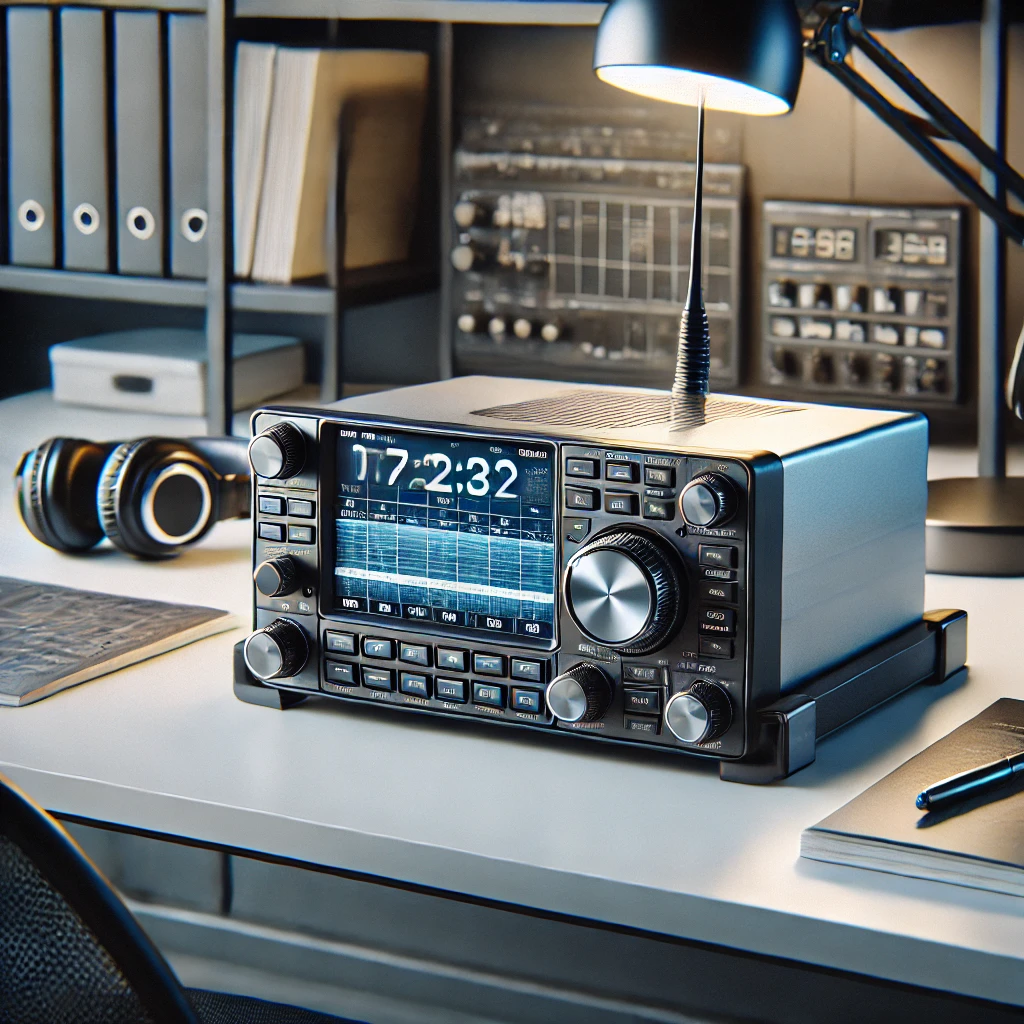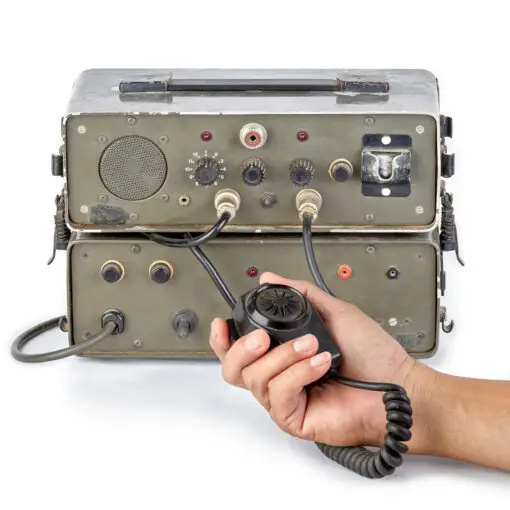Ham radios are vital tools for communication, especially during emergencies when other forms of communication might fail. As their popularity grows, several brands have established themselves as leaders in the market, offering reliable and high-quality devices. Finding the best ham radio brand means evaluating multiple factors like performance, build quality, and usability.

This article will explore five top ham radio brands that stand out for their innovative features and trusted reputation among users. Whether for beginners or seasoned operators, these brands provide a range of options to meet various needs and preferences.
1) Icom IC-7300

The Icom IC-7300 is highly regarded in the ham radio community. This radio features a built-in sound card, touch screen interface, and spectrum scope. These elements make it a favorite among both beginners and experienced users.
One of the standout elements is its user-friendly interface. The touch screen allows for easy navigation and quick adjustments. The spectrum scope provides real-time feedback, making it easier to identify active frequencies.
Affordability is another aspect that attracts many users. Priced around $900 to $1,100, it’s considered a mid-range option. Users point out that the performance to cost ratio is impressive, making it a practical choice.
The IC-7300 also covers a wide frequency range, including HF, 6-meter, and 4-meter bands. This wide coverage makes it versatile for various communication needs. The design and build quality add to its appeal, ensuring durability and reliability.
For those interested in additional features, the Icom IC-7300 also includes digital signal processing. This enhances sound clarity and overall communication quality. More information on the IC-7300 can be found on the Ham Radio Store.
Many users appreciate the IC-7300 for its balance of ease of use, advanced features, and durability. It’s a well-rounded choice for both new and seasoned ham radio operators.
2) Yaesu FT-991A
The Yaesu FT-991A is a versatile all-band transceiver. It covers HF, VHF, and UHF bands, making it ideal for a variety of operating conditions.
This radio stands out with its Real-Time Spectrum Scope. The display is bright and clear, enabling easy monitoring of the band.
The FT-991A supports multiple modes including CW, AM, FM, SSB, and digital modes like PSK31. This flexibility appeals to many radio enthusiasts.
Its build quality is noteworthy. The solid cast monolith frame provides excellent durability.
With advanced features like the sophisticated active cooling system, the radio maintains performance during long sessions.
The Yaesu FT-991A is also known for its ease of programming. When paired with ADMS-991 software, configuration becomes straightforward.
For those looking for a reliable and adaptable ham radio, the Yaesu FT-991A is an excellent choice. More detailed user reviews can be found here.
3) Kenwood TS-590SG
The Kenwood TS-590SG is a popular model known for its high performance and reliability. According to reviews on eHam.net, it has a rating of 4.6 stars out of 5. Users appreciate its ruggedness and value for money.
A standout feature of the TS-590SG is its advanced DSP (Digital Signal Processing) technology. This helps to reduce noise and improve signal clarity, making it a top choice for amateur radio enthusiasts. The transceiver also benefits from an effective roofing filter, which cuts down on unwanted signals.
Some users have compared the TS-590SG to the Icom 7300. While many are satisfied with the Kenwood model, a few prefer the Icom 7300 for its easier menu system and color spectrum display. Nonetheless, the TS-590SG remains highly regarded in the ham radio community.
Kenwood’s focus on performance is evident in this model. The company website describes the TS-590SG as a new generation transceiver that pushes technology to its limits. This commitment to innovation helps Kenwood stay competitive.
Overall, the Kenwood TS-590SG stands out for its build quality, advanced features, and favorable user reviews. Its combination of technologies and user-friendly design makes it a strong contender in the ham radio market.
4) Elecraft KX3
The Elecraft KX3 is renowned for its versatility and compact design. As a top choice among skilled ham radio operators, it excels in both transceiver and shortwave receiver functions. Its power output ranges from 0 to 10 Watts, making it suitable for various communication modes.
One notable feature is its broad compatibility with USB, LSB, CW, data, AM, and FM. This flexibility allows users to engage in diverse communication practices. The KX3’s power efficiency is impressive, consuming less than 150mW in receive mode, which helps save battery life.
The Elecraft KX3 also acts as an excellent broadcast receiver. Users have praised its ability to deliver clear signals, making stations like the Voice of Greece sound high-quality. This enhances the overall user experience, especially when using headphones.
Moreover, the KX3 is built with portability in mind. Its compact size and lightweight build are ideal for field use. This makes it a favored choice for operators who prefer on-the-go communication.
Despite being one of the pricier field radios, the KX3 is often considered worth the investment. It is available on the used market, making it accessible for those looking for a more budget-friendly option. Users rarely regret purchasing a KX3, praising its performance and reliability.
5) Alinco DX-SR8T
The Alinco DX-SR8T is a versatile HF transceiver that appeals to both beginners and experienced ham radio operators. It offers a detachable front panel, which makes it convenient for mobile operation and tight spaces.
This model operates with a high power output of up to 100 watts, ensuring strong signal transmission. Power output can vary between 107 watts and 120 watts, depending on the band in use.
The DX-SR8T supports various digital modes, allowing operators to enjoy a wide range of communication options. Its compatibility with digital modes makes it a good choice for those looking to explore beyond traditional voice communications.
The stock microphone is reliable and provides clear audio quality. Users report that the microphone works exceptionally well, although some have encountered issues when using more complex audio setups such as audio racks and studio microphones.
This transceiver is priced competitively, making it accessible for many enthusiasts. Although some find it priced around $600, it can be found for about $530, which many consider a good deal.
For basic HF use and digital modes, the Alinco DX-SR8T receives positive feedback from users who appreciate its balance of features and cost. Further information can be found through user reviews on eHam.net.
History of Ham Radio
Ham radio, also known as amateur radio, has a rich and diverse history. Its journey spans from the early 20th century through significant technological advances that continue to influence modern communication.
Early Beginnings
Ham radio started in the early 1900s, around the same time radio technology was in its infancy. Enthusiasts, known as ham radio operators, began experimenting with transmitting signals over long distances. These early operators used rudimentary equipment but were able to achieve impressive communication feats.
In 1912, the U.S. government introduced the Radio Act, which required amateur radio operators to be licensed. This regulation helped organize the growing number of hobbyists. During World War I, ham radio was temporarily shut down, but it revived quickly afterward. Ham radio operators played important roles in emergency communications during disasters, showcasing the importance of this emerging technology.
Technological Advancements
Over the years, ham radio technology evolved dramatically. By the mid-20th century, operators were using more sophisticated equipment, which improved signal clarity and range. The invention of the transistor in the 1950s and later microprocessors in the 1970s significantly advanced ham radios, making them more reliable and accessible.
Digital modes became popular, allowing operators to send data and images over radio frequencies. Modern ham radios now include features such as satellite communication, internet connectivity, and digital encryption. These technological strides have kept ham radio relevant, and it remains a valuable tool for hobbyists, emergency responders, and scientific researchers alike. The development of these technologies has cemented ham radio’s place in the history of communication.
Key Features of Top Ham Radio Brands
Top ham radio brands such as Yaesu, Icom, Kenwood, and Baofeng are known for their durability, performance, and user-friendly interfaces. Each brand offers distinct features that appeal to different types of users, from beginners to seasoned radio enthusiasts.
Durability
Durability is a critical feature when considering a ham radio. Yaesu radios are reputed for their robust build quality. They are designed to withstand harsh conditions, making them a top choice for outdoor use and emergencies. Icom models also feature sturdy construction, often with water-resistant or waterproof capabilities, ensuring they can handle wet environments. Baofeng offers affordable options that, while not as rugged, still provide a good degree of resilience for casual use.
Performance
When it comes to performance, Kenwood radios stand out with their clear audio and reliable signal transmission. They are ideal for both basic and advanced users seeking dependable communication. Icom is known for innovative technology, such as high-frequency stability, which enhances overall performance. Their radios often include features like advanced GPS and digital capabilities. Yaesu radios are highly praised for their cutting-edge transceivers, providing excellent range and clarity. These features make them suitable for a variety of communication needs.
User-Friendly Interfaces
Ease of use is a major consideration for ham radio enthusiasts. Kenwood radios are known for their intuitive controls, making them accessible even to beginners. They incorporate clear, easy-to-read displays and simple menu navigation. Baofeng offers user-friendly interfaces that are straightforward and easy to learn, ideal for those new to ham radio. Icom also excels with well-designed interfaces and LCD screens, which provide a great user experience for both novices and experts. They focus on making advanced features easily accessible.
Combining durability, high performance, and user-friendly interfaces, these brands cater to a wide range of users with varying needs and preferences. Whether for casual use, emergency preparedness, or serious hobbyist communication, there’s a ham radio to fit every situation.
Comparative Analysis
When comparing ham radio brands, it’s crucial to assess both price versus value and the quality of customer support. Understanding these factors helps users make informed decisions based on their specific needs.
Price Vs. Value
Yaesu is known for delivering high-quality devices at a moderate cost. Their products typically offer great performance and longevity, making them a strong candidate for those looking at long-term investment.
Kenwood radios are ideal for novices and come at a varied price range. While they might be pricier than some budget options, their build quality and feature set justify the cost for many users.
ICOM offers a range of products from budget-friendly to high-end. They are known for innovative designs and advanced features. Even though some models can be expensive, their functionality often matches the price.
Baofeng is a go-to for budget-conscious buyers. While their units are less expensive, they still provide excellent basic functionality, making them a favorite among beginners.
Brands like TYT offer specialized radios that balance cost with specific features appealing to those with targeted needs.
Customer Support
Yaesu excels in providing reliable customer support. Users appreciate the detailed manuals and availability of parts, which enhances the user experience.
Kenwood is equally strong in customer service, offering easy-to-access support channels and frequently updated resources. This is especially helpful for new users who might need more guidance.
ICOM has a reputation for responsive and knowledgeable customer service. Their agents are often able to solve technical issues quickly, ensuring minimal downtime for users.
Baofeng provides basic customer service, which aligns with their budget-friendly product offerings. While not as comprehensive as other brands, the community support available can often fill this gap.
TYT offers solid support for their niche products. Their technical assistance is praised by users who require specific configurations or use cases.
Frequently Asked Questions
This section addresses key aspects when selecting and using ham radios, including criteria for base stations, suitable handhelds for various users, and advancements in the latest technologies.
What should one consider when choosing a ham radio base station?
When selecting a ham radio base station, it’s important to look at features like frequency range, power output, and ease of use. Models such as the Icom IC-7300 and Yaesu FT-991A are noted for their versatility and user-friendly interfaces.
Which ham radio handheld is recommended for both beginners and seasoned users?
For those new to ham radios and experienced users alike, the Yaesu FT-60R and Baofeng UV-5R are great choices. These models offer reliable performance and a good balance between cost and features.
How do different ham radio brands compare for long-distance communication?
For long-distance communication, brands like Icom and Kenwood excel. The Kenwood TS-590SG is known for its strong signal reach and stability, making it a favored choice among ham radio enthusiasts who need extended range capabilities.
What are the top features to look for in a ham radio for emergency preparedness?
In an emergency, a ham radio’s portability, battery life, and ease of operation are crucial. Handheld models like the Yaesu FT-60R offer robust emergency communication solutions due to their durable build and long-lasting battery.
What makes a ham radio suitable for entry-level users?
Entry-level ham radios should be affordable, easy to use, and offer essential features without overwhelming new users. The Baofeng UV-5R is popular among beginners due to its simplicity and cost-effectiveness.
How has the latest 2024 ham radio technology improved over previous years?
The 2024 ham radio models feature better digital interfaces, improved battery life, and enhanced signal clarity. Models like the Icom IC-7300 incorporate software improvements and advanced filtering techniques to enhance the user experience significantly.





